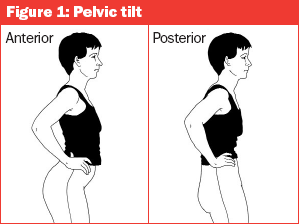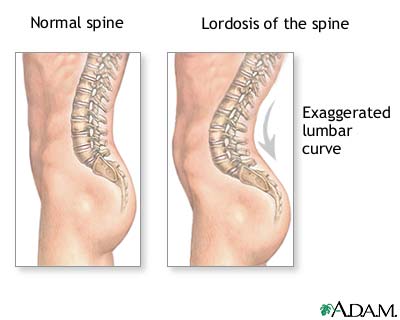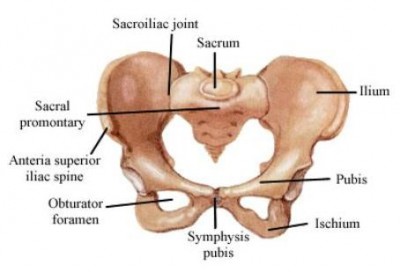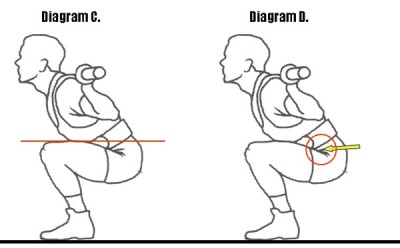Awesome quote:
Evan: Do you cycle (insinuating road biking)?
Dr. Metzler: Periodically.
Periodically I get questions on whether or not the “butt wink” is an issue. The first thought that comes to mind is “who the hell thought of the term ‘butt wink’?” Winking requires the closing of an orifice, and everybody knows that in order to close your outer sphincter, you have to clench your butt cheeks together. You can’t do this while squatting, and if you do, you’re doing a half squat. So stop, god dammit.
Editor’s Note: Yes, there’s more than one sphincter. What?
2nd Editor’s Note: I don’t recommend Google image searching “butt wink” with the safe search “off”.
The butt wink is a made up term to refer to the alleged posterior tilt of the pelvis at the bottom of a squat. Posteriorly tilting the pelvis is the same motion you’d make if you wanted to hit your pubic bone against a wall (guys will probably crush their junk in the process). It’s important to note that observed butt winks are McCarthy’d when a person is doing a body weight squat (i.e. without a barbell). During a body weight squat, the trainee is told to keep their back in hardcore extension to avoid the wink. There are a few trainees that need this kind of cuing to achieve a proper spinal alignment, and those who don’t get in the habit of over-extending their thoracic and lumbar spine. The body weight (BW) squat is commonly (and incorrectly) taught as a precursor to a barbell squat, and the progression is misleading since they teach incorrect extension and mechanics during a barbell squat.
The BW squat is an incorrect first step because of the means and the end. The mechanics of it are unimportant since it isn’t loaded with additional weight and the squat itself is routinely executed safely after dropping a deuce everyday (two or three times if you’re me — yeah c’mon). It is also used as a conditioning tool — NOT a strength builder. Trying to claim that the BW squat will build strength is like saying non-alcoholic beer gets you drunk. Floozy.
Every person’s body dimensions will not be able to fit the mold of an “upright torso” anyway. A person with long femurs and a short torso must lean over when squatting all the way down in order to manipulate their body to have a stable center of mass (unless they are wearing Lady Gaga’s heels). Furthermore, some trainees won’t have the flexibility to get to the proper depth in a BW squat. If the same trainee places a barbell on their back, it provides a little more external resistance that helps push them down into proper depth. This is similar to PNF (proprioceptive neuromuscular facilitation) stretching; elongating a muscle as it attempts to provide a resistance to the stretch. A trainee in this situation is not using enough weight to cause harm (anywhere between 45 and 95 lbs), and in fact the weight is helping them achieve proper depth, let their muscles stretch, and working all of the muscles around the knees and hip through a full range of motion. A coach who has their thumbs anywhere but in their ass can easily teach this correctly.
The above addresses the lack of logic in battling against a “butt wink” in a BW squat and dealing with an inflexible trainee, but what about the wink itself? Does it happen under a load? If it does, should we all be concerned? Frankly, I’ve never had a situation where there’s a “butt wink” worth worrying about. Lifters should be taught to shove their knees out when squatting, whether they are doing high bar, low bar, or front and overhead squats. Shoving the knees out avoids any impingement, bony or soft tissue, and is explained in detail by Mark Rippetoe in several sources. Not shoving the knees out is probably the culprit for most “butt winking”, so the point is almost moot.
Let’s say there is a little “winking” (I keep putting it in quotes because the term is fucking ridiculous) going on when barbell squatting. It’s unlikely that it’s caused by tight hamstrings since those hamstrings are allowing a full depth squat (with knees out). There are two reasons I’ve thought of for this happening. The first is related to the “over extended back thing” that is taught in the BW squat. If a trainee over extends their back under a load, the spinal column is now in an inefficient position to transfer force. There are two points where problems typically occur: where the thoracic spine meets the lumbar spine, and where the lumbar spine meets the sacrum. If either area is “over extended” tremendous forces are no longer passing through them to the pelvis (and subsequently legs) and instead are pinching the posterior and opening the anterior portions of vertebral segments. Not good.
Don’t think it can happen? Well it does. Aside from hearing about it regularly, a 70’s Big reader recently wrote in and told me they herniated a disc because they were trying to over-correct the horrid “butt wink”. That’s a damn shame. You need your trunk to be straight when lifting so that your spine doesn’t look like a parabola (one that has the y coordinate squared). A coach with clean thumbs can take care of this.
Let’s say that a trainee is taught to over-extend their back on a BW squat, and then does the same thing on light barbell squats. The weight won’t be significant enough to hurt them (and it shouldn’t when teaching squat technique), but their pelvis will naturally pull out of this over-extension at the bottom of the squat. This will appear to be flexion, and it is because the pelvis posteriorly tilts to go back into a neutral alignment because it was extended too far to begin with. A shitty coach says, “Flexion! You are banished from the bar to only perform ‘air squats’ until you get it right!”, but it’s their own fault for teaching the asinine over-extension position. This issue constitutes nearly ALL of the “butt wink” cases that occur when the trainee is correctly shoving their knees out (if they aren’t shoving the knees out, then the aforementioned hip impingement will create the wink).
The other cause for a “but wink” could be anatomical. In coaching it is extremely important to identify different body dimensions and how they affect mechanics. After observing many limbs and trunks, I started noticing differences in pelvis length. The pelvis itself starts at the sacrum (below the last lumbar vertebrae), wraps around your sides in the form of the iliac crest, and then the pubis closes in from each side on the front of your body at a connection called the pubic symphysis. Usually pelvis variations aren’t a big deal, but if a person has a very long pelvis it alters how they look when squatting or deadlifting. Their low back never looks like it’s extended and can even look like it is lumped out, appearing to be in flexion. Instead, their pelvis may be long enough such that it doesn’t produce a fancy lordotic curve when in position (particularly the bottom of a squat and the start of a deadlift). I’m not saying this is the case all of the time, but it is definitely a possibility; it isn’t crazy to assume pelvises come in varying lengths/widths while we commonly accept that spinal columns, femurs, tibias, humeri, and radii/ulnas all vary in size and shape.
While I’ve noticed varying pelvis lengths in adults, it’s more noticeable in children and adolescents. I haven’t studied a whole lot on bone development, but this age group seems to grow femurs and pelvises before spinal columns. Looking back, the majority of kids I’ve coached are included in this anatomical observation. A trainee with a long pelvis will probably look like they are doing something wrong, but may just look funny because of their anatomy. This structural issue may be what is causing the dirty thumbed coach to shout “butt wink”.
Hopefully after learning some of the anatomy and conceptual lessons here you have a better understanding of why the “butt wink” is horse shit. In general, trainees should shove their knees out when squatting and this will allow proper depth. If a “wink” is occurring in a BW squat, it doesn’t fucking matter because it’s a Body. Weight. Squat. It’s used for conditioning and deuce dropping. When someone McCarthies a “butt wink” on a weighted squat and the trainee is shoving their knees out, that person is either a shitty coach, a pervert, or flamboyant because they are clearly staring at the lifter’s ass. Properly coached squats don’t really have “butt winks”, and if they do, I think it can be explained by their anatomy (and they aren’t a big deal anyway).





